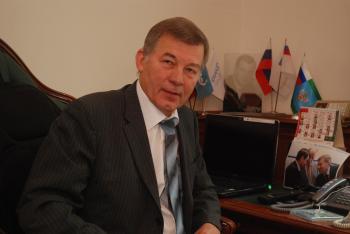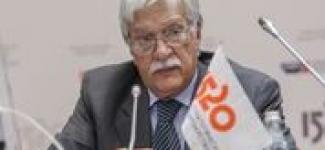Home › Projects › White Book › Transport Education: Main Challenges
Transport Education: Main Challenges

Modern economic and social challenges brought about by both issues specific to Russia and by integration processes in the METR region are giving rise to increasingly complex requirements for accelerated development of the transport sector. Yet the response to changes in the transport arena has been less than the response in banking or other sectors.
As head of one of METR’s leading transport universities, I believe that transportation systems should be developed with a view to the future, anticipating the emerging challenges. Human capital is the main component of transportation systems. This concerns not only highly qualified specialists who maintain existing infrastructure and vehicles, but also designers and builders, scientists and researchers whose intellectual endeavors are shaping the future of industry. Consequently, the most important condition for the development of scientific and human resources for transport is the accelerated development of transport education.
Two issues must be addressed to improve the efficiency of transport education: the training of a new type of transport specialist and the development of a practical orientation in university research. Powerful educational and research centers focused on solving the industry’s problems will enable the training of this next generation of specialists. Only the efforts of a new generation of specialists, scientists and teachers can make such centers more innovative, practical and business-oriented.
Orienting toward the needs of employers, anticipating the nature of educational infrastructure formation, providing continuing education at all levels, promoting an interest in applied scientific research: These concepts, plus the impact of transportation’s evolution, have always
distinguished industrial transport education in Russia. The fundamental tasks of transport universities are the following: maximizing staff performance in the transport sector to support the country’s development; creating the means for continuing education in the field; and efficiently integrating transport science achievements and professional education in collaboration with leading universities and transport structures around the world.
We believe that the farthest-reaching attribute of the next-generation transport university is its ability to ensure effective development of the ever-growing area of communications. We would like to see the transport university become the uniting force of an effective partnership between different branches of transport, between the transport business and the academic community, science and education, science and industry, pure science and applied science in the innovation cycle, national transport systems, and educational and scientific organizations in various countries.
In addition, a transport university should integrate new educational and information technologies into the educational process, as well as connect university classroom spaces and the modern youth information environment. All of this involves a combination of principles: the principles of continuing and advanced education, classical and technical education, and university models for applied sciences, innovation and entrepreneurial education.
The specific industrial system of vocational education can be considered an achievement of Russia’s transport sector. At the start of this decade, technical schools and colleges for transport education became part of vertically integrated university systems. Also, transport businesses have maintained integrated systems for teaching staff in their own internal training departments. In turn, that has allowed the Russian transportation industry to avoid staff shortages.
Vertical connections between organizations and institutes, as well as continuing education within pre-agreed and pre-defined programs, have been significantly improving the process of training specialists of various skill levels. Those two steps have produced other results as well, including helping future transport employees learn and adapt to system-wide, standardized technological processes and safety requirements. A particular note can be made of targeted training systems,
which are based on contractual relationships with employers and provide guaranteed employment. This creates additional opportunities for developing students’ skills by means of learning components pegged to a future workplace.
Another priority of Russian transport education is the development of a unified, multilevel system of continuing education, which includes continuing professional education and advanced training. Matters such as forming professional standards, equipping educational institutions with working models and facilities in collaboration with businesses, and developing networks of institutes and centers are all essential for success.
In general, the goal of the transport university is to create specialists across a wide range of fields who are able to adapt to new technologies and who then improve themselves on their own initiative. This adaptable, self-directed approach is necessitated by the type of evolution that occurs in the transport sector, which is demanding a transition from mere improvements to breakthrough innovations.
In some ways, there has been a return to the practices seen during the birth of modern transportation, when engineers become designers and creators of technology and infrastructure and then operators of their own inventions. This is the optimum goal of transport education.
The minimum goal is the creation of self-sufficiency based on university knowledge, which would allow graduates to adapt to modern technologies faster and more effectively.
In all circumstances, the mission of transport universities cannot be implemented without first finding out what the actual eligibility criteria are in the actual business environment. A practical assessment of the employability of the institute’s graduates and their knowledge, capacities, and potential for professional growth are essential.
The needs of staff development for the transport sector coincide with the overall objectives of education. They include:
- improving ways of implementing educational programs, such as by developing new majors, creating modular and supplementary courses, networking different types of education and introducing interactive learning;
- increasing student commitment to practical activities, such as by having the university jointly develop professional standards with future employers, by updating training programs and developing branch laboratories, research and educational centers;
- optimizing the formal and legal organization of universities and improving management, such as by creating a board of regents and an endowment;
- developing the promotion system in the industry, including by forming employment centers at universities, offering professional testing and certification, and improving forms of employment monitoring.
Key requirements for specialist training are brought about by the conditions of transportation process implementation as a set of systematically interrelated technologies. Those requirements are the combination of basic engineering training with practical skills; the systemic coherence of the curricula of vocational and higher education programs; the presence of highly skilled academic staff; and the availability of laboratory equipment and working models.
Another issue is how to give students a new, wider range of capacities, driven by industry dynamics and environment.
They include capacities in digital and information technology, communication and legal areas, and foreign languages. Demand for economic knowledge and for skills in business, customer orientation, safety and other areas is appearing mainly because companies are placing a higher value on such abilities.
One important trend is the development of intermodal transport and general transportation competencies. In modern conditions, the majority of transport workers — and not just managers — need to interact not only with subcontractors for their company and their particular mode of transportation, but with a wide range of organizations involved in transport activities, multimodal transportation, logistics, regional transport networks and transport corridors.
Special attention is being paid to the development of competences in the field of international standards, information exchange and electronic workflow, satellite monitoring of freight transportation, and route scheduling of goods traffic, among other areas.
New technologies have been applied to specific areas of training. This is especially the focus of specialized departments at MIIT, which are carrying out simulations and modeling in collaboration with leading companies. A range of projects — parallel computations, enormous dataset processing, uses of the emerging technologies known as NBIC (nanotechnology, biotechnology and information and cognitive technologies), multidimensional simulations in five or six dimensions — are all actively taking root.
Computer-based simulation is the means for carrying out projects — for example, calculation of freight flows — for most of the technical branches. Regarding the introduction of new materials and devices, student competencies are developed by synthesizing fundamental knowledge with an analysis of how modern technologies came to be. Areas that might be explored include nano-materials in transport engineering, polymer coatings in transport construction, space navigation, laser technologies and superconductors for magnetic levitation on railways. Prototype technologies are also used in the learning process.
We can hardly expect the overnight appearance of new specializations in the transport industry. At the same time, new specializations will appear due to new transportation modes such as high-speed transport and transport-logistics technologies. We can expect the same expansion in multimodal transportation, complex transportation systems, public transport systems and transport safety, primarily at the infrastructure level. The big trends will appear as gradual changes in professional capacities, the expansion of job descriptions, and the efforts that graduates make to acclimate themselves to new technologies and technical facilities.
Introduction of modern information technologies into the education system is one of the trends that will have increasing impact in the longterm. It is affected by the speed of information evolution and the appearance of “Internet generations” — Generation Z born between 1995 and 2009 and Generation Alpha born in 2010and later — for whom a digital environment is perfectly natural.
Transport technologies have changed as well. We already have seen several generations of technologies in communications, signaling, dispatching, navigation. This process of innovation and change is continuing. Here we are talking about the synergy of four factors: technological demand in the industry; innovations by teachers and students, who are the bearers of digital culture; fast transmission of knowledge and ideas; and skill training and competency oversight.
Meanwhile, learning spaces have diverged into two modes: a cloud or remote mode (cloud technologies, video communications) and an interactive mode in classrooms (interactive boards, touch screens). Both modes use interactive game-like approaches drawn from business and other areas. The number of traditional lectures delivered in lecture halls goes down every year. Today’s lessons are uploaded onto a web server or distributed via electronic media for self-study. Many web applications have been created in MIIT, particularly for students, and these services are developing constantly.
Some long-term, futuristic forecasts even predict that technology will allow a teacher’s hologram to educate and test students remotely. Technologically, we can already create completely virtual interactive education with complete control.
But classes in lecture halls can’t be fully replaced by homework via the Internet. Besides acquiring knowledge, it is very important for students to be trained in specific skills, which requires direct interpersonal communication. A balance should be found, including in education for basic transport professions, primarily in traffic safety. It’s too early to speak about substituting classical education in engineering disciplines.
Currently, a business incubator with Internet resources is being created in MIIT. It will take a completely new approach to communication between mentors, teachers and students. All of MIIT’s partners will be represented in this incubator resource, and the system will allow students to participate in the process of solving business challenges at various companies. Such technologies are a step toward education integration in the METR region. Without such integration, it’s impossible to speak about increasing transport mobility, because those who create it should speak “with one language.”
http://www.kommersant.ru/doc/2747375
Sign up for MIR initiative email updates
Sign up to receive monthly notifications about new arctiles published and other events on your email.
Other articles
 Pablo Vazquez Vega
Pablo Vazquez Vega
Assessment of infrastructure projects
 Will Judge
Will Judge
Connecting Cities: Global transit solutions
 Alessandro Pansa
Alessandro Pansa
The will to move on
 Eugenio Muzio
Eugenio Muzio
Eurasian High-Speed Metro for Freight Transportation
 Jochen Eickholt
Jochen Eickholt
The future of digitalized mobility
 Jean-Pierre Loubinoux
Jean-Pierre Loubinoux
